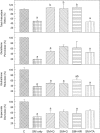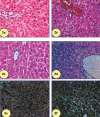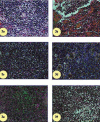Comparative evaluation of some flavonoids and tocopherol acetate against the systemic toxicity induced by sulphur mustard
- PMID: 20040938
- PMCID: PMC2792600
- DOI: 10.4103/0253-7613.42304
Comparative evaluation of some flavonoids and tocopherol acetate against the systemic toxicity induced by sulphur mustard
Abstract
Objective: To evaluate the protective value of quercetin, gossypin, Hippophae rhamnoides (HR) flavone and tocopherol acetate against the systemic toxicity of percutaneously administered sulphur mustard (SM) in mice.
Materials and methods: Quercetin, gossypin, HR flavone or tocopherol acetate (200 mg/kg, i.p.) were administered just before percutaneous administration of SM and protection against the SM lethality was evaluated. In another experiment quercetin, gossypin, HR flavone or tocopherol acetate were administered against 2 LD(50) SM. The animals were sacrificed seven days post SM administration and various biochemical parameters were estimated.
Results: The protection against the lethality of SM was very good with the flavonoids (quercetin = 4.7 folds; gossypin = 6.7 folds and HR flavone = 5.6 folds), compared to no protection with tocopherol acetate (0.7 fold). SM (2 LD(50)) showed decrease in reduced and oxidised glutathione (GSH and GSSG) levels, and an increase in malondialdehyde level (MDA). Oxidative stress enzymes like glutathione peroxidase, glutathione reductase and superoxide dismutase were significantly decreased. The total antioxidant status was also significantly decreased. Additionally, there was a significant increase in red blood corpuscles and hemoglobin content. All the flavonoids significantly protected the GSH, GSSG and MDA, and also the hematological variables. Tocopherol acetate failed to offer any protection in those parameters. Gossypin protected glutathione peroxidase, while HR flavone protected both glutathione reductase and glutathione peroxidase significantly. The decrease in body weight induced by SM and the histological lesions in liver and spleen were also significantly protected by the flavonoids but not by tocopherol acetate.
Conclusion: The present study supports that SM induces oxidative stress and flavonoids are promising cytoprotectants against this toxic effect.
Keywords: Gossypin; Hippophae rhamnoides flavone; oxidative stress; quercetin; sulphur mustard.
Figures


Control liver showing normal hepatic parenchyma, hepatic lobules and hepatocytes,
SM administered mice liver (2 LD50) showing granulovacuolar degeneration and perinuclear clumping of cytoplasm,
Quercetin administration with SM, showing reduced hepatic lesions,
Gossypin administration with SM showing lesser magnitude of hepatic lesions,
HR-flavone administration with SM showing protection of hepatic degeneration,
Tocopherol acetate administration with SM showing marginal protection.

Control spleen showing normal splenic parenchyma germinal centre, red and white pulp,
SM administered mice spleen (2 LD50) showing congestion, hypocellularity and parenchymal degeneration,
Quercetin administration with SM showing protection with lesser hypocellularity,
Gossypin administration with SM showing lesser magnitude of splenic degeneration,
HR-flavone administration with SM showing minimal lesions,
Tocopherol acetate administration with SM showing marginal protection.
Similar articles
-
Prophylactic effect of gossypin against percutaneously administered sulfur mustard.Biomed Environ Sci. 2007 Jun;20(3):250-9. Biomed Environ Sci. 2007. PMID: 17672217
-
Protective effect of ethanolic and water extracts of sea buckthorn (Hippophae rhamnoides L.) against the toxic effects of mustard gas.Indian J Exp Biol. 2006 Oct;44(10):821-31. Indian J Exp Biol. 2006. PMID: 17131913
-
Protective effect of various antioxidants on the toxicity of sulphur mustard administered to mice by inhalation or percutaneous routes.Chem Biol Interact. 2001 Mar 14;134(1):1-12. doi: 10.1016/s0009-2797(00)00209-x. Chem Biol Interact. 2001. PMID: 11248218
-
Dermal intoxication of mice with bis(2-chloroethyl)sulphide and the protective effect of flavonoids.Toxicology. 1991;69(1):35-42. doi: 10.1016/0300-483x(91)90151-p. Toxicology. 1991. PMID: 1926154
-
Evaluation of analogues of DRDE-07 as prophylactic agents against the lethality and toxicity of sulfur mustard administered through percutaneous route.J Appl Toxicol. 2006 Mar-Apr;26(2):115-25. doi: 10.1002/jat.1114. J Appl Toxicol. 2006. PMID: 16421877
Cited by
-
Combination therapy of N-acetyl-L-cysteine and S-2(2-aminoethylamino) ethylphenyl sulfide for sulfur mustard induced oxidative stress in mice.Toxicol Rep. 2021 Mar 17;8:599-606. doi: 10.1016/j.toxrep.2021.03.011. eCollection 2021. Toxicol Rep. 2021. PMID: 33842212 Free PMC article.
-
Possible Treatment Approaches of Sulfur Mustard-Induced Lung Disorders, Experimental and Clinical Evidence, an Updated Review.Front Med (Lausanne). 2022 Apr 29;9:791914. doi: 10.3389/fmed.2022.791914. eCollection 2022. Front Med (Lausanne). 2022. PMID: 35572987 Free PMC article. Review.
References
-
- Fox M, Scott D. The genetic toxicology of nitrogen and sulphur mustard. Mutat Res. 1908;75:131–68. - PubMed
-
- Somani SM, Babu SR. Toxicodynamics of sulfur mustard. Int J Clin Pharmacol Ther Toxicol. 1989;27:419–35. - PubMed
-
- Papirmeister B, Feister AJ, Robinson SL, Ford RO. Medical defense against mustard gas: Toxic mechanisms and pharmacological implications. Boca, Raton: CRC Press; 1991. p. 359.
-
- Casillas RP, Kiser RC, Truxall JA, Singer AW, Shumaker SS, Niamuth NA, et al. Therapeutic approaches to dermatotoxicity by sulfur mustard: I, Modulation of sulfur mustard induced cutaneous injury in mouse ear vesicant model. J Appl Toxicol. 2000;20:S145–51. - PubMed
-
- Sawyer TW, Lundy PM, Weiss MT. Protective effect of an inhibitor of nitric oxide synthase on sulfur mustard toxicity in vitro. Toxicol Appl Pharmacol. 1996;141:138–44. - PubMed
LinkOut - more resources
Full Text Sources
Research Materials

